A few summers ago, I was gardening with my mom in the back of her house when we stumbled upon something that looked too amazing to be true. A gorgeous Reishi mushroom was growing on the stump of a hemlock tree underneath the fence between her and her neighbor’s yard!
You know, Reishi, the “king of herbs” in Chinese medicine? Scientifically known as Ganoderma and believed by ancient Taoists to be a core ingredient in the elixir of everlasting life? Yup, right there in my mom’s quaint little yard about 60 miles outside of New York City.
I had heard there were some great mushroom harvests to be had in the woods north of her home, but finding one in her shrubs was definitely unexpected.
The simple lesson here is that we don’t need to go far to find the medicine. We fall into the habit of thinking that the transformation or wild prescription for us exists in an exotic location “elsewhere,” but oftentimes they can be found right under our noses if we just open our eyes and take a look.
“Give nature half a chance and she has a miracle in store for everyone.” – Rosita Arvigo
Below, I’ve shared 9 common low-growing medicinal herbs and 1 mushroom that you may want to search for in your own backyard or surrounding neighborhoods – plus, we’ve also noted which regions they can be found in. This is a good reason to keep your backyard chemical-free—and of course make sure you wash everything thoroughly before preparation and consumption.
Since some of these herbs have potent effects, be sure to look up any potential contraindications with regard to pregnancy, allergies, ailments, or other medications you may be taking.
*One more note: You’ll want to do additional research on those edibles you do find in your own backyard, to see if they align with your personal needs. And if you find something promising that’s not on this list, take it to your local nursery for help in identification. With a little research, you can discover whether or not that plant has properties worth using, or if it’s one to avoid.
Ok, let’s dive in!
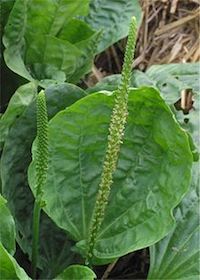 1. Broadleaf Plantain (Plantago major): Unlike the large plantain trees that grow delectable fruits, the broadleaf plantain is a ground cover. Packed with Vitamin K, calcium, and other vitamins and minerals, the broadleaf plantain has a cleansing and detoxifying effect on the body. This medicinal plant has been used in treating colds, diarrhea, burns, open sores, wounds, mouth ulcers, boils, acne, throat pain, sunburn, fever, respiratory infections; improving liver and kidney function; relieving gastrointestinal inflammation; and drawing out poisons and toxins from bites and stings—even snake bites! It’s often used as an anti-inflammatory and an analgesic, and you can make it into a tea, poultice, or salve. Where it grows – North America, Europe, Australia and Asia.
1. Broadleaf Plantain (Plantago major): Unlike the large plantain trees that grow delectable fruits, the broadleaf plantain is a ground cover. Packed with Vitamin K, calcium, and other vitamins and minerals, the broadleaf plantain has a cleansing and detoxifying effect on the body. This medicinal plant has been used in treating colds, diarrhea, burns, open sores, wounds, mouth ulcers, boils, acne, throat pain, sunburn, fever, respiratory infections; improving liver and kidney function; relieving gastrointestinal inflammation; and drawing out poisons and toxins from bites and stings—even snake bites! It’s often used as an anti-inflammatory and an analgesic, and you can make it into a tea, poultice, or salve. Where it grows – North America, Europe, Australia and Asia.
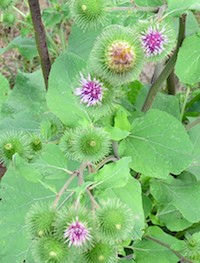 2. Burdock (Arctium lappa): Burdock Root is an antioxidant powerhouse and has been used in Chinese Medicine for thousands of years. Some of its traditional uses include removing toxins from the blood, inhibiting certain types of cancers, treating skin issues, and acting as an aphrodisiac. It’s also a natural diuretic, so be sure to hydrate properly. Consume in moderation. Consider trying in a tea, fresh root form, or dried root powder. Where it grows – North America, Europe, Australia and Asia.
2. Burdock (Arctium lappa): Burdock Root is an antioxidant powerhouse and has been used in Chinese Medicine for thousands of years. Some of its traditional uses include removing toxins from the blood, inhibiting certain types of cancers, treating skin issues, and acting as an aphrodisiac. It’s also a natural diuretic, so be sure to hydrate properly. Consume in moderation. Consider trying in a tea, fresh root form, or dried root powder. Where it grows – North America, Europe, Australia and Asia.
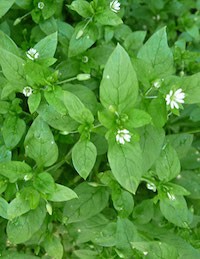
3, Chickweed (Stellaria media): Chickweed is known as a natural skin rejuvenator, with both cooling and drying effects on wounds, sores, minor burns, acne, eczema, psoriasis, and other skin inflammations. It has also been used for constipation and relieving irritated eyes. Chickweed is a rich source of Vitamin C and potassium, and also provides nutritious trace vitamins and minerals. It fell out of style as a popular salad green, so you may want to try it that way first, or perhaps make chickweed vinegar by infusing it with apple cider vinegar. For topical use, create a salve from the plant’s essential oils. Where it grows – North America, South America, Central America, Europe, Australia and Asia.
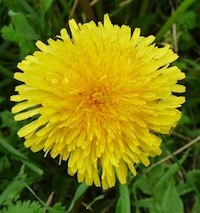 4. Dandelion (Taraxacum officinale): Perhaps the most prolific and recognizable, the dandelion is greatly undervalued. This beneficial plant is often found in some of the finest herbal teas, and is used for its healing benefits to treat high blood pressure, calcium deficiency, cancer, diabetes, diverticulitis, irritable bowel syndrome, urinary tract infections, and eczema and psoriasis; detoxify the liver; aid digestion; and reduce inflammation. Use in salad greens, or dry the leaves and roots to make a tea. Where it grows – North America, South America, Central America, Europe, Australia and Asia.
4. Dandelion (Taraxacum officinale): Perhaps the most prolific and recognizable, the dandelion is greatly undervalued. This beneficial plant is often found in some of the finest herbal teas, and is used for its healing benefits to treat high blood pressure, calcium deficiency, cancer, diabetes, diverticulitis, irritable bowel syndrome, urinary tract infections, and eczema and psoriasis; detoxify the liver; aid digestion; and reduce inflammation. Use in salad greens, or dry the leaves and roots to make a tea. Where it grows – North America, South America, Central America, Europe, Australia and Asia.
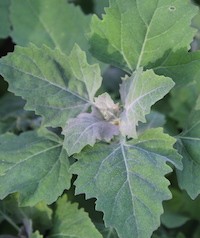 5. Lamb’s Quarters (Chenopodium album): This “prince of wild greens” is a common garden weed packed with enough protein to rival spinach, along with Vitamins A and C, calcium, phosphorous, iron, and a multitude of minerals. Our ancestors prized this plant’s medicine for its purification properties to “improve the blood,” and also to treat rheumatism and arthritis, toothaches and tooth decay, constipation, insect stings, eczema, and gout. Keep seed consumption to a minimum, but freely consume the leaves, shoots, and flowers. Eat fresh leaves and flowers mixed in with your other salad greens; steam or stir fry along with your favorite vegetables; or cook and puree with some of your favorite soups. You can also grind seeds into flour. Where it grows – North America, Europe, Australia, Africa and Asia.
5. Lamb’s Quarters (Chenopodium album): This “prince of wild greens” is a common garden weed packed with enough protein to rival spinach, along with Vitamins A and C, calcium, phosphorous, iron, and a multitude of minerals. Our ancestors prized this plant’s medicine for its purification properties to “improve the blood,” and also to treat rheumatism and arthritis, toothaches and tooth decay, constipation, insect stings, eczema, and gout. Keep seed consumption to a minimum, but freely consume the leaves, shoots, and flowers. Eat fresh leaves and flowers mixed in with your other salad greens; steam or stir fry along with your favorite vegetables; or cook and puree with some of your favorite soups. You can also grind seeds into flour. Where it grows – North America, Europe, Australia, Africa and Asia.
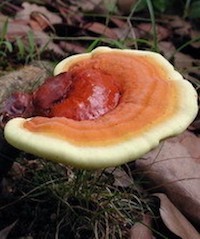 6. Reishi Mushroom (Ganoderma lucidum): If you are fortunate enough to live in an area where the reishi grows, you may already be aware of its long-touted healing properties. Mainly used in prevention of disease, the reishi offers protection against inflammation, various infections, skin disorders, diabetes, heart and liver disease, sleep disorders, digestive problems, cancer, fatigue, anxiety, depression, and viruses, including HIV/AIDS and hepatitis. It also helps to restore hormonal imbalance, and regulates various cellular functions. Because of its slightly bitter flavor, it’s traditionally dried and then prepared for a tea, or pulverized into a powder and mixed into your favorite protein shake. Where it grows – Eastern North America, South America, Europe and Asia.
6. Reishi Mushroom (Ganoderma lucidum): If you are fortunate enough to live in an area where the reishi grows, you may already be aware of its long-touted healing properties. Mainly used in prevention of disease, the reishi offers protection against inflammation, various infections, skin disorders, diabetes, heart and liver disease, sleep disorders, digestive problems, cancer, fatigue, anxiety, depression, and viruses, including HIV/AIDS and hepatitis. It also helps to restore hormonal imbalance, and regulates various cellular functions. Because of its slightly bitter flavor, it’s traditionally dried and then prepared for a tea, or pulverized into a powder and mixed into your favorite protein shake. Where it grows – Eastern North America, South America, Europe and Asia.
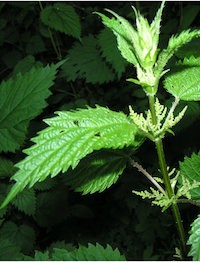 7. Stinging Nettle (Urtica dioica): Be careful—this herb can sometimes “sting” and leave a rash when bare skin comes into contact with the acid-filled needles. Once boiled, however, the nettles leave you with leaves that, when ingested, provide nutritious elements and anti-inflammatory properties. Nettle leaves have been used in treating allergy symptoms, lowering blood pressure, improving immune system response, reducing pain, acting as a diuretic, treating skin conditions, thickening hair while also reducing dandruff, and causing a sedative effect. The plant’s root has been used to address prostate concerns in men. Handle and harvest while wearing gloves, and then boil or cook to remove the sting from the nettles. The easiest and perhaps most common way to use nettles are in a tea, where you can flavor with other herbs or spices to taste. But once cooked, you can also use nettle leaves like most other greens and use in salads, or season and bake them (like kale chips), or grind to make a pesto. For the roots, toss them in a stir fry or dry like the leaves for use in a tea. Where it grows – Western North America, Europe, Northern Africa and Asia.
7. Stinging Nettle (Urtica dioica): Be careful—this herb can sometimes “sting” and leave a rash when bare skin comes into contact with the acid-filled needles. Once boiled, however, the nettles leave you with leaves that, when ingested, provide nutritious elements and anti-inflammatory properties. Nettle leaves have been used in treating allergy symptoms, lowering blood pressure, improving immune system response, reducing pain, acting as a diuretic, treating skin conditions, thickening hair while also reducing dandruff, and causing a sedative effect. The plant’s root has been used to address prostate concerns in men. Handle and harvest while wearing gloves, and then boil or cook to remove the sting from the nettles. The easiest and perhaps most common way to use nettles are in a tea, where you can flavor with other herbs or spices to taste. But once cooked, you can also use nettle leaves like most other greens and use in salads, or season and bake them (like kale chips), or grind to make a pesto. For the roots, toss them in a stir fry or dry like the leaves for use in a tea. Where it grows – Western North America, Europe, Northern Africa and Asia.
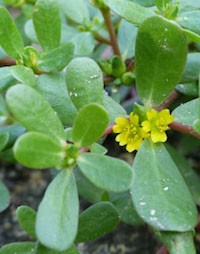 8. Purslane (Portulaca oleracea): Purslane is an excellent source of fiber; Vitamins A, B, and C; iron, calcium, magnesium, manganese, potassium, copper, and powerful antioxidants. Our ancestors have used it for hundreds of years to prevent and cure disease. It’s been used to treat high cholesterol, diarrhea and other gastrointestinal disorders, skin conditions, and cancer. It’s believed to improve type 2 diabetes, vision, strengthen bones, increase circulation, and aid in weight loss. Try it mixed with salad greens. Where it grows – North America, South America, Central America, Europe, Africa, Australia and Asia.
8. Purslane (Portulaca oleracea): Purslane is an excellent source of fiber; Vitamins A, B, and C; iron, calcium, magnesium, manganese, potassium, copper, and powerful antioxidants. Our ancestors have used it for hundreds of years to prevent and cure disease. It’s been used to treat high cholesterol, diarrhea and other gastrointestinal disorders, skin conditions, and cancer. It’s believed to improve type 2 diabetes, vision, strengthen bones, increase circulation, and aid in weight loss. Try it mixed with salad greens. Where it grows – North America, South America, Central America, Europe, Africa, Australia and Asia.
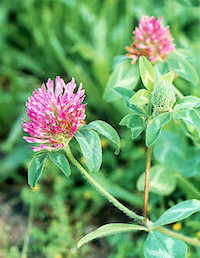 9. Red Clover (Trifolium pratense L.): Menopause symptoms. Maintaining bone strength. Improving cardiovascular health. Lowering risk for various types of cancers. Reducing skin inflammation. Fighting respiratory infections. Detoxifying the liver. Boosting the immune system. Managing cholesterol. Balancing hormones. Boosting cognition. These are just some of the many disorders and “symptoms of aging” that red clover has been used to treat. Dry the herb to make a tea, or make a salve for a topical medicine. Where it grows – North America, South America, Central America, Europe, Australia and Asia.
9. Red Clover (Trifolium pratense L.): Menopause symptoms. Maintaining bone strength. Improving cardiovascular health. Lowering risk for various types of cancers. Reducing skin inflammation. Fighting respiratory infections. Detoxifying the liver. Boosting the immune system. Managing cholesterol. Balancing hormones. Boosting cognition. These are just some of the many disorders and “symptoms of aging” that red clover has been used to treat. Dry the herb to make a tea, or make a salve for a topical medicine. Where it grows – North America, South America, Central America, Europe, Australia and Asia.
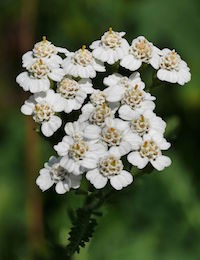 10. Yarrow (Achillea millefolium): This pretty little flowering herb is wonderful for healing skin conditions; stopping bleeding (external); encouraging bleeding in cases of amenorrhea; alleviating anxiety; acting as a mild sedative; reducing inflammation; and treating mastitis, high blood pressure, asthma, and muscle spasms. Use fresh leaves in salads, soups, or sautéed dishes, or use dried leaves as a cooking herb. Where it grows – North America, Europe and Asia.
10. Yarrow (Achillea millefolium): This pretty little flowering herb is wonderful for healing skin conditions; stopping bleeding (external); encouraging bleeding in cases of amenorrhea; alleviating anxiety; acting as a mild sedative; reducing inflammation; and treating mastitis, high blood pressure, asthma, and muscle spasms. Use fresh leaves in salads, soups, or sautéed dishes, or use dried leaves as a cooking herb. Where it grows – North America, Europe and Asia.
Many of these herbs are sold in supplement form, but you can bypass the middle-man and go directly to the source by taking a look around and experimenting on your own. Perhaps LA-based guerilla gardener Ron Finley says it best:
“Growing your own food is like printing your own money.”
Stay curious,
Nick Polizzi
Host of Remedy: Ancient Medicine for Modern Illness
& Founder of The Sacred Science
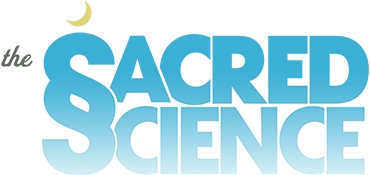
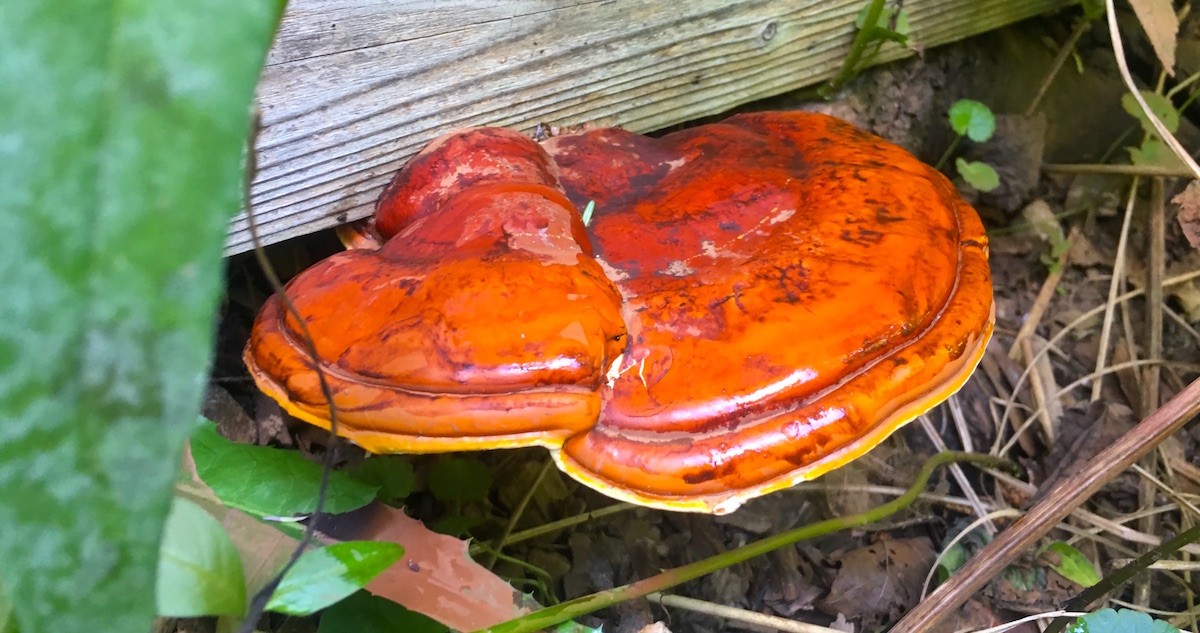

76 Responses
Thank You for this gift.
This is great information – thank you. I’m very inspired as I let my garden go wild, and now found oregano and wild strawberries growing – a perfect gift. Always a little concerned about identifying mushrooms though…….
Hello, thank you for sharing the knowledge with the world. What a gift.
Thank u.. Very helpful 🙏🏽🙏🏽🙏🏽🙏🏽
Thank you for sharing your beautiful, important and health sustaining wisdom.
I would add the common pigweed, sometimes called redroot, that grows abundantly in many cultivated fields. Its leaves are not as colorful as its caribbean cousin, callaloo, but it’s just as delicious. I have not researched it’s constituents, but it is so delicately delicious that it just feels healthy. Lightly steamed and dressed with olive oil, salt, pepper, a little lemon or vinegar maybe, it is a culinary treat not to be missed!
Thank you for this information. Do you have a list of medicinal and edible plants that can be found in southern United States,? I live in Florida and would like to recognize the plants specific to my region.
Thank you, Nick. I’d been eating some of these as pot herbs without realizing they have medicinal value, too. For the reader from Florida–most of these grow here. eattheweeds.com has a wealth of information and addresses both culinary and medicinal uses.
Thank you for all the information about the possible use of herbs.
I have lyme disease and just started using a homemade reishi tonic. I will let you know how it is improving my condition.
I am a forager in New England and in Belize. I welcome anyone’s comments or suggestions
I have lyme disease and just started using a homemade reishi tonic. I will let you know how it is improving my condition.
I am a forager in New England and in Belize. I welcome anyone’s comments or suggestions
Thanks again for the great information. I love these emails…
Regards, Judi
Great information. some of the plants are rare in Africa. Yarrow (Achillea millefolium): Reishi Mushroom (Ganoderma lucidum): Chickweed (Stellaria media): to name but a few I have never set my eyes on. The rest can be found around locally growing as weeds. Good message,
keep it up.
I know some mushrooms are poisonous so i stay clear of them. I think I ha e seen Reishi but did not know it. If thais how theylook I will be onthe lokout for them in my area.
Wonderful and helpful information, thanks
WATCHED A PROGRAM ON WILD MUSHAROOM ,SAW PEOPLE PICKING OUT OF FIELDS.
Thanks for your post. Red Clover (Trifolium pratense) is a great plant. Good to have it on your list. It also grows in Slovenia, it is very common. We have more information about the plant on our website (curently stil only in slovenian lenguage): http://rozma.si/. Best regards
Aloha Nick !
Mahalo so much for this Amazing and Critical contribution to Hamanity !
I am truly grateful and look forward to the new
Documentary.
I am now finally delving into my Ancestors realms of Plant healing and Medicine.
I am mixed with a rich cultural background of Hawaiian, California Native, Northern African, Gypsy, and more….
It is time for is to learn and use what is offered as gifts to help us on our journeys.
Mahalo for your journey….It is making a difference.
Aloha
Malama pono
Nic these are great ,good to know they’re in Aust ,cheers mate best regards mike
Hello, do you know of any herbs that can grow in the dessert We live in Dubai so interested to know this
Hi Nick
Most of these also grow in Southern Africa too so they’re pretty much worldwide. I have recently started using dandelion leaves and flowers from my garden in my morning green juice 🙂
PS. Despite my email having uk at the end, I live in Cape Town. Also most of these grew in my garden in Harare, Zimbabwe when I lived there.
I want to get information about (Ganoderma fungus) and planting and planting it.
Thanks for sharing this important information with humanity. Clearly the answer is all around us, in the nature. Just need to take the time and search for it. Thanks again for reminding us!
In 2014 after the smart meter installation, my health decreased tremendously and became electrosensitive. The one thing that helped me most was the Dynamic Neurofeedback and therefore after herbs, and detox. I am not 100% but close. If any recommendation, I remain open. Thanks & Blessings!
Nick,
Your on-line video series is potentially world shaking. I want to send you a private message about an idea I have for your work. Would you mind sharing an email address so i could send the letter to you?
Thanks,
great information …thank you….
check out this link watch the mushroom
I am fortunate to live in FL, where Centella asiatica (Gotu kola) occurs in nearly every county. I have a yard FULL of Centella, and I regularly use the leaves in salads, soups, and stir fries. I also load up the dehydrator to dry the leaves for longer storage or to ship to freinds, and I use the dried leaves in a variety of tea blends, as well as under the coffee grounds in every pot I perk. Centella has been used for thousands of years, and in recent years has been entering more and more products in the US (e.g., a Life Extension product to stabilize and reduce arterial plaque). Search both “Centella” and “Gotu kola” on the greenmedinfo.com research dashboard, and you will be amazed. Herbal farms in NC are growing acres of Centella. Try it!
(I tried, but was unable to insert a photo)
THANK YOU so much for all that you share so freely.
Do you know that purslane is the highest source of Omega 3 (essential) fatty acids of any green plant? And some consider it a weed? It can be eaten raw or cooked. Yum.
Thank you so much! With the exception of Reishi we have everything else growing right in our own back yard. We also have Feverfew which is effective for migraines. It should not however, be prepared as a tea because it can cause Internal bleeding because of its aspirin like properties.
Of course I cant be sure, but it looks like that Reishi mushroom is growing out of a pressure treated piece of lumber. If so, personally, I’d not eat it.
Gotta be careful with lamb’s quarters, it’s high in oxalates. Best to steam it and throw out the steam water. There are several varieties of l.q. – the ones with the larger, greener, more serrated leaves are typically more palatable. You can also eat the greens from l.q’s cousin, quinoa.
I love this article Nick and the photos are great. You have a really interesting and unique news letter. Thanks so much.
Thank you. Very informative.
I would like to know if a very old Reishi Mushroom, that has turned to stone is still useable and how can I process it?
My other question is about the red clover and what part is usable for making an extract? Doesn’t day in the artikel. Thx. MoiRa
I think this is great, I am just too unsure if I would be identifying them correctly. To see exactly what the “weed” is I’m thinking that the local nursery would be able to tell, do you agree? Too bad I just did my vegetable garden, but weeds to keep growing 🙂
Very interesting and thank you.
Interesting information and good article. Here in the southeast, u.s. I’ve been trying to learn more about the wild herbs that grow here and their uses. Does anybody use the wild lettuce that grows so abundantly here? Until recently I had no idea that the plant could be so beneficial. I thought it was just a weed I had to pull up.
I find dandelion flowers are the tastiest part of the plant – their flowers were not mentioned here. But, great article!
What a great and informative article! Thank you. 🙂
Nick! Love your blog! Thank you for its clarity and integrity. Too many blogs lead you to a
“sales pitch,” I appreciate your educational intent.
Would like to learn more about finding and recognizing herbs in my area.
Spending more time in the nearby woods due to COVID-19 stay in place orders, I discovered a patch of oyster mushrooms growing up the side of a dead birch near a spot I must have walked hundreds of times. Mother Earth misses us. She has so many gifts to offer. When we slow down and commune with life around us, those gifts become more and more visible, even right in our own backyard!
Thank you for all your knowledge and sharing. I am 87 yrs. Was an R.N. studying Holistic ways all my life. Not on any pharmaceuticals, thank God and still learning.
Thank you, this was so interesting and informative and I’m delighted to have found your blog. I live in South Africa but this plant looks familiar, I’m definitely going on the hunt!
Thanks for this very useful list of herbal remedies.
I’ve been a “mushroom hunter” for many years and can identify many of them here in Switzerland. In regards to the Reishi mushroom, it is easily mistaken for other tree funguses, some of which are poisonous. It is not that easy to identify as there are a number of very similar ones which cannot or should not be consumed.
So, to be on the safe side get a book or guide on mushrooms before you tackle that one. Seriously!
Best and good luck,
Irene
Thank you sooo much for the info.
I am 35 from Thailand, Last year I accidentally came to know that I have contracted Hepatitis B. I actually don’t know how or when I contracted it but I have it. I was so much depressed to learn about it but World Herbs Clinic website(ww w worldherbsclinic c om)was a blessing for me, I am thankful to everyone here. After three months of using their HBV FORMULA, my test result came out negative..Please don’t neglect this testimony, because is 100% real.
Thanks.
We had a mullein plant show up in our yard last year. I am making cough syrup with the flowers right now. It is also an amazing wild plant.
Thank you for this information. Do you have a list of medicinal and edible plants that can be found in South Africa I live in Johannesburg and would like to recognize the plants specific to my region.
Amazing information.
So glad I am an ardent follower of most of your programms,
Mahalo so amazing you gift us with this wonderful information for better health.
We are blessed..
Stay well..
Blessings Love*Light*
Thanks for connecting!
Just such wonderful information I would certainly be interested in finding of where I could possibly locate books remedies ancient medicine for the modern illness and the sacred science. Can you find them on Amazon ? thank you
Yes, there are many resources to find this information. Many of the teachers we feature on our Remedy series have written prolifically on the subject – KP Khalsa, Rosemary Gladstar to name a couple. We also feature David Winston on our Proven series, another amazing herbalist.
I love this!
What wonderful info on the backyard plants. I would love to learn more about these and other plants. I did use the plantain before for a sting and it works so well just chewed up and put on the sting. The sting just went away so quickly. There is so much to learn. Its so exciting. Thank you so much.
Since you asked me to “share my wisdom” I feel I should. It’s not much but I think it’s an important lesson I have learned. I am a senior in very poor health with serious autoimmune going on. I have been reading a bit about herbs here and there over the past couple of years and began to grow a few. Then, I noticed something amazing. It seems when I need them the herbs begin to show up in my life. For example, my aching tight muscles are a misery. The stuff the hospital and doctors give me is smelly, strong and unpleasant. I had been reading about comfrey. Then one day when I went to inspect my lone peony by the fence line bordering a neighbor, there she was! She had starting growing behind the peony. My neighbor had been all summer trying to kill her and she escaped under my side of the fence. The neighbor asked me if I wanted them to dig her up and I said NO! I told her she was safe with me and I would use her for medicine. She is now my medicine of choice for those aching muscles. The next one was yarrow. I found her crouched in the corner of a flower bed my son had made. She seemed almost shy, hugging the corner so tightly. I had been having a lot of trouble with stuffy nose etc. She is my sinus/allergy medicine. The point of this story is that when we respect the natural world and we need it , we may find a nice surprise and realize the Mother has been listening all along. Thanks for asking!
Yarrow is a fantastic plant. I used it in an emergency on both my grandmother and my father internally when they had internal bleeding, and it stopped it! Also had an experience with a woman who couldn’t get her high blood pressure meds and it helped her tremendously. Obviously the above isn’t medical advice, merely experiences that I had.
With the pharmonopoly and FDA eyeing supplements, learning what’s local to support the body is a good skill to have.
Purslane – can be fermented with a brine (like old-fashioned pickles) – nice with fall/winter meal!
Stinging nettles – rinse hands with baking soda & water to neutralize the acid in its tiny spikes.
very useful, Thanks for sharing
we have all but the reishi mushrooms on the property. have been out gathering and drying mullein, cleavers, chamomile, lemon balm, have many others to gather or eat fresh.
Thank you, Nick. For me it is the most valuable information I’ve been looking for… I found the majority of the plants in my backyard. The information is really a precious gift for me… Thanks again.
Hello
For bone and teeth regeneration wich herbs do you suggest me?
Reishi and…?
I live in Italy.
I have no garden
Hello is there a link to.purchase the products a.s to you do capsule form in-regards to dandelion and mushroom.
I love your blogs, thank you!
Always love you information. Thanks Mary
I have used fresh dandelion leaves and root for my dog’s Cushing disease. All symptoms of this cruel disease are resolved since adding this to his raw diet, which also includes sauerkraut and brown rice. No panting, no excessive thirst or hunger or failing leg muscle and joints. His stamina is extraordinary at 14 yrs this November. His blood work fascinates the vet which I use for lab work only, rejecting all Rx suggestions. They tolerate me as I try to explain what I’m doing. I understand if they put their clients on this diet, they would put themselves out of business! Real medicine, I believe, is intuitive. I feel often like a loner, until I hear Nick speaking about his connection to herbalism and then I realise this goes back to the very first appearanece of humans. We have strayed far off the path but I see it coming back in the insights of true naturopaths like Nick. Natural healers unite! Sean
good for you, Sean! way to go, practice what you preach, all for the good of man and animal…
At this time especially when economic prognostications warn of an economic storm on the horizon ,such information is a gold mine .Thank you so much for sharing.
This information is sooo needed by most everyone in this country
bc of all the unhealthy ways our commercial farmers are growing our food. If you can only do one thing…grow your own herbs & heal yourself!!
I follow you and read almost all mails. A million thanks for the healing plants description
Thanks for this enlightenment. We try to observe and preserve nature where we live. A mushroom that has persistently grown on the base of our Norfolk pine tree (Auricaria sp) looks like Ganoderma lucida shown in your illustration. But West Africa is not mentioned among locations where this mushroom grows. Because some mushrooms are poisonous, there is reluctance to their use as food and medicine here. I shall like to identify this visitor that we had thought was an unwelcome guest coming to terminate our pine!
It’s always a pleasure to listen and read what you have to say in the emails that you send I have so many of these little plants in my garden. I live in Alberta Canada when I was little I was sent out to pick dandelions for salad and dig up the roots which my grandmother made Coffee out of we ate nettles and lambs quarters we called it pig weed. We ate it like spinach. The only one I don’t have on your list is the Rishi mushroom I don’t think it grows here though. I still grow all my own food and on my acreage I am 83 I lost just about everything this last week to terrible hail storm. Not bad. I’ve lived here since 70 70 this was the most challenging year I’ve ever experienced 80° in May. Never heard of that here anyways Nick for all your information very uplifting❤️
I’ve been fascinated with this since I was probably 5 years old (really). Growing up, probably not too far from where your mother lives, I had the great fortune to live in an area where I could traverse far and wide and find all kinds of edibles. I seem to have known about them from very young on. I could always naturally identify most all the wild plants growing in the area. This goes back to what I realized when watching the program on shamanism. What I have, I have credited to “Fate”, which is what I think of the situation I exist under. Your guest speaker not only clarified this, but I far better understood everything after listening to her. What she described is quite accurately me. And the fact that I have naturally drifted into becoming a helper, or what I like to call a “mentor”, all of which came naturally, was, again, actually what she described. I’ve always wondered just exactly how I fit into all of this, and how it fit into me, so much was clarified with that program. I’ve understood this about me for a long time, now, but her information gave it new meaning. I didn’t need to explore, and then try to make it happen over a long time…it just happened naturally. If I were to tell you all the weird things that seemed to mold my life, my safety, and so many events, you might be amazed. I have also experienced “ghosts, or spirits”, and have done what she talked about, and helped them adjust to their situation. I have little hints and clues all the time, and you’d be surprised if I told you how they occur, that steer me in certain directions and be able to make certain decisions. I am able to determine certain events, activities, and other occurrences for future situations. The spirits I access are considered by me to be Fate, or “the Fates”. It all comes together if you let it happen. Anyhow, I became fascinated with Euell Gibbons, and I’ve read all his books…fascinating. I also can communicate with plants, and certain “animals”, especially birds, snakes, certain insects, horses, and a number of other animals that I have been able to spend some time with, and/or been in a position to connect with them. this, again is what she talked about. She also talked about the connection with people. Being connected to several Native Americans from various tribes, I became familiar with auras, and now I understand them perfectly, and they fully explain my connection with people “out of the blue”. I have been around the world, and all this facilitates me perfectly wherever I am. This is just a touch of my “shamanism” and how it completely affects my life (I’ve been a teacher, a mentor, a landscaper, a naturalist, an actor, a fitness and nutrition consultant, and so much more, so you can see how my life path is affected by my “spiritual authority. Thanks for this article. It ‘feeds” my “spirit”.
Really makes me take the greens I see almost daily ….A treasure of healing right in my yard and in nearby wooded path!!!! Thank you to all nature lovers for opening the eyes of our complex world to the Loving Work of our Holy Creator!!!!
Thanks! I raised my kids in rural VA and all these lovely plants were superabundant there.
Appreciate…got me into a lifetime journey with herbs and superfoods!